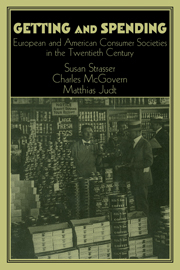Book contents
- Frontmatter
- Introduction
- Part One Politics, Markets, and the State
- 1 The Consumers' White Label Campaign of the National Consumers' League, 1898-1918
- 2 Consumption and Citizenship in the United States, 1900-1940
- 3 Changing Consumption Regimes in Europe, 1930-1970: Comparative Perspectives on the Distribution Problem
- 4 Customer Research as Public Relations: General Motors in the 1930s
- 5 The New Deal State and the Making of Citizen Consumers
- 6 Consumer Spending as State Project: Yesterday's Solutions and Today's Problems
- 7 The Emigré as Celebrant of American Consumer Culture: George Katona and Ernest Dichter
- 8 Dissolution of the “Dictatorship over Needs”?: Consumer Behavior and Economic Reform in East Germany in the 1960s
- Part Two Everyday Life
- Part Three History and Theory
- Index
5 - The New Deal State and the Making of Citizen Consumers
Published online by Cambridge University Press: 05 January 2013
- Frontmatter
- Introduction
- Part One Politics, Markets, and the State
- 1 The Consumers' White Label Campaign of the National Consumers' League, 1898-1918
- 2 Consumption and Citizenship in the United States, 1900-1940
- 3 Changing Consumption Regimes in Europe, 1930-1970: Comparative Perspectives on the Distribution Problem
- 4 Customer Research as Public Relations: General Motors in the 1930s
- 5 The New Deal State and the Making of Citizen Consumers
- 6 Consumer Spending as State Project: Yesterday's Solutions and Today's Problems
- 7 The Emigré as Celebrant of American Consumer Culture: George Katona and Ernest Dichter
- 8 Dissolution of the “Dictatorship over Needs”?: Consumer Behavior and Economic Reform in East Germany in the 1960s
- Part Two Everyday Life
- Part Three History and Theory
- Index
Summary
When historians trace the expansion of a mass consumer economy and society in twentieth-century America, they inevitably focus on eras of economic prosperity, such as the 1920s and 1950s, when consumer markets expanded and merchandisers innovated in advertising, retailing, and credit. This focus on the dynamic moments of producer and consumer interaction in the private economic sphere, however, misses the crucial role that state policy-making played in creating a postwar world where mass consumption not only shaped the economy, but also altered the political realm, becoming a new vehicle for delivering the traditional American promises of democracy and egalitarianism. As a mass consumption-driven economy made possible a more adequate standard of living for more people than ever before in the decades after World War II, the consumer in the economic realm became increasingly identified with the citizen in the political realm. Full participation in American postwar society came to mean a complicated intermeshing of the economic and political rights of “citizen consumers.” The larger study I have undertaken will examine in depth what I call the “Consumer's Republic” that emerged after World War II. Related to that study, this essay challenges a periodization for the growth of mass consumer society that stresses eras of economic prosperity and argues instead that the Great Depression of the 1930s - as a crucial period of modern American state building - established the groundwork for the centrality of consumption and consumers in the postwar era.
- Type
- Chapter
- Information
- Getting and SpendingEuropean and American Consumer Societies in the Twentieth Century, pp. 111 - 126Publisher: Cambridge University PressPrint publication year: 1998
- 12
- Cited by



